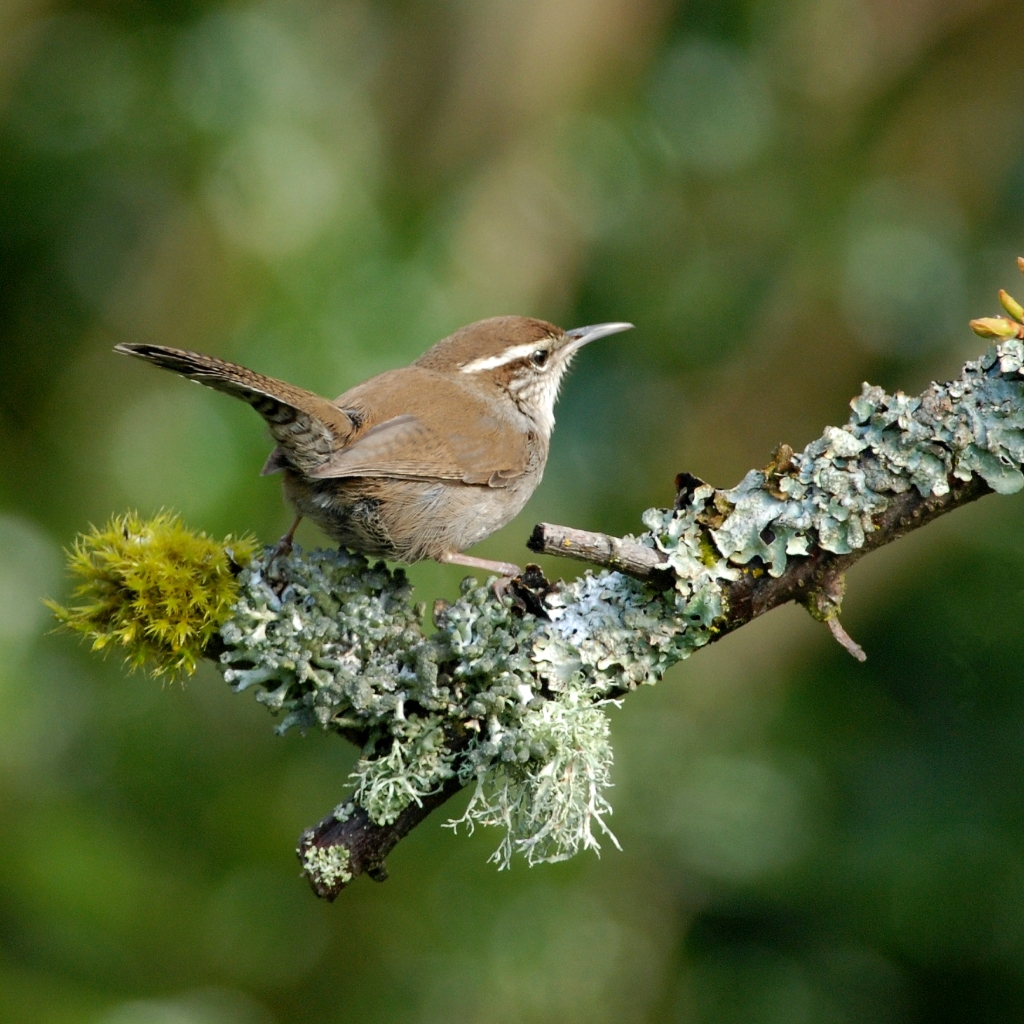
Scientific Name
Thryomanes bewickii nesophilus
Introduction
The Bewick's wren is an endemic subspecies found on Santa Cruz, Santa Rosa and Anacapa Islands. It is a small, noisy, hyperactive little bird with bold white eyebrows, flicking its tail as it hops from branch to branch.
Quick and Cool Facts
- This species is named after British engraver Thomas Bewick-a friend of pioneering bird artist John James Audubon, who collected the first recognized specimen.
- Courting Bewick's wrens normally form monogamous pairs. While they're setting up house and even after the female has begun incubating eggs, the male and female often forage together. This may help the male prevent his partner from mating with another bird.
- At the sound of approaching humans, a female Bewick's wren incubating eggs usually flushes quietly from her nest cavity, but remains nearby and scolds. Some females, however, sit tightly on their eggs even when disturbed.
- The male Bewick's wren learns its song while still on the parents' territory.It learns the song not from its father, but rather from the neighboring territorial males. The song repertoire developed before the first winter is retained for life.
- The Bewick's wren can live up to 8 years.
Appearance
This Bewick's wren is grayish-brown above with an obvious whitish eyebrow which extends back down the neck. The subspecies in the park is overall somewhat darker. It has a long, fanned tail, although the park's subspecies tail is smaller. Its tail is often cocked upward, which it flips and jerks from side to side as well as rises slowly up and down. The top and bottom of the tail is barred with black and you might be able to see the white spots on the outer tail feathers when the tail is fanned. This wren has whitish underparts and an unstreaked back. The bill is long and slightly downcurved. The legs and feet are gray. Both adults look similar. The juvenile is like the adult but has dark edges to its feathers.
Range
Bewick's wrens are resident along the West Coast, throughout the southwestern U.S., and in parts of the eastern U.S. They leave some eastern breeding areas in the winter. The population is stable, except in the eastern U.S., where it is declining. The endemic subspecies, Thryomanes bewickii nesophilus, is found on Santa Cruz, Santa Rosa and Anacapa Islands, while a different subspecies, T. b. catalinae, occurs on Santa Catalina Island.
Habitat
Bewick's wrens favor dry brushy areas, chaparral, scrub, thickets in open country, and open woodlands near rivers and streams. They are at home in gardens, residential areas, and parks in cities and suburbs. On the Channel Islands, based on recent surveys, nesophilus favors chaparral, pine forest, riparian, and/or woodland habitats.
Feeding
Bewick's wrens eat the eggs, larvae, pupae, and adults of insects and other small invertebrates. Common prey include bugs, beetles, bees and wasps, caterpillars, butterflies, moths, grasshoppers, crickets, flies, and spiders. Bewick's wrens also occasionally eat seeds, fruit, and other plant matter, especially in winter. Bewick's wren nestlings receive mostly caterpillars, spiders, grasshoppers, and insect pupae. Adults sometimes consume pebbles and mud, perhaps for nutrients or to help with the grinding digestion of their food. The subspecies found in the park rarely feeds on seeds and generally gleans invertebrate prey from the lower branches of small trees and shrubs and from the stems of large herbaceous plants.
Reproduction
The Bewick's wren's cup-shaped nest has a base of sticks, grasses, rootlets, leaves, moss, or other plant materials, depending on what the local environment provides. Many contain spider egg cases. The open cup may be lined with feathers, wool, hair, or plant down. The male initiates nest building; both sexes participate. The construction process usually takes less than 8 days, though sometimes it can stall for long periods and require weeks to complete. The nest is about 2.5 to 3 inches high and 4 or 5 inches in diameter, the cup about 1-2 inches deep and 2-2.5 inches in diameter.
The nesting period of the Bewick's wren begins with a clutch of 3 to 8 eggs laid in its cup shaped nest. From 1 to 3 broods may be laid in one season, but two would be the norm. The size of the egg would approximate two-thirds in length and about one half an inch in width. The eggs would be described as white with reddish -brown or purplish spots. The incubation period for bewickii would be from 14 to 16 days. The weight of the new hatchlings would be about 1/20th of an ounce and find its eyes tightly closed; its skin pink, with sparse down. After hatching, both parents bring foof to the nest. Generally, at two weeks the young leave the nest.
Conservation Status
The Bewick's wren is identified as a species of Least Concern by the ICUN Red List because the species has an extremely large range, and hence does not approach the thresholds for Vulnerable under the range size criterion.
Additional Information
- http://www.birdinginformation.com/birds/wrens/bewicks-wren/
- http://www.allaboutbirds.org/guide/bewicks_wren/id
- http://www.oiseaux-birds.com/home-page.html
- http://www.iucnredlist.org/details/106006938/0
- http://www.birdzilla.com/birds/Bewicks-Wren/description.html
- http://www.planetofbirds.com/passeriformes-troglodytidae-bewicks-wren-thryomanes-bewickii
- Coonan, T. J., R. C. Klinger and L. C. Dye. 2011. Trends in landbird abundance at Channel Islands National Park, 1993-2009. National Park Service, Natural Resource Stewardship and Science. Fort Collins, Colorado. Natural Resource Technical Report. NPS/CHIS/NRTR-2011/507. Published Report-2180888.
Is there something we missed for this itinerary?
Itineraries across USA


















































